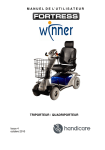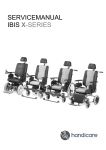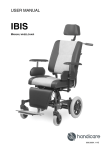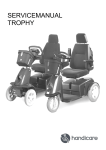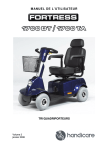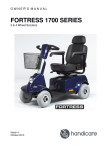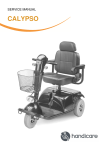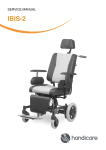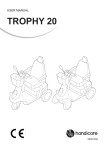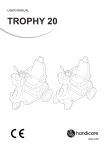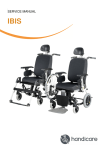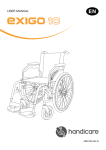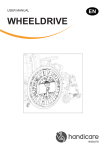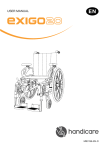Download Owner`s Manual - Fortress Winner
Transcript
OWNER‘S MANUAL 3 & 4 Wheel Scooters Issue 4 October 2010 Handicare® All rights reserved. The information provided herein may not be reproduced and/or published in any form, by print, photoprint, microfilm or any other means whatsoever (electronically or mechanically) without the prior written authorisation of Handicare®. The information provided is based on general data concerning the constructions known at the time of the publication of this manual. Handicare executes a policy of continuous improvement and reserves the right to changes and modifications. The information provided is valid for the product in its standard version. Handicare® cannot be held liable for possible damage resulting from specifications of the product deviating from the standard configuration. The available information has been prepared with all possible diligence, but Handicare® cannot be held liable for possible errors in the information or the consequences thereof. Handicare accepts no liability for loss resulting from work executed by third parties. Names, trade names, etc. used by Handicare® may not, as per the legislation concerning the protection of trade names, be considered as being available. XXXXXX-000001000-en.doc 2 Table of contents Introduction ........................................................................................ 5 This manual ........................................................................................ 5 Product labels..................................................................................6-7 Symbols used in manual.................................................................... 8 Service and technical support........................................................... 9 Identification plate.............................................................................. 9 Identification of the product .............................................................. 9 Warranty....................................................................................... 10-11 Use according to purpose ............................................................... 12 1 General safety regulations and instructions............................ 13 1.1 Labels and instructions on the scooter ............................ 13 1.2 Technical specifications................................................... 13 1.3 Modifications ................................................................... 13 1.4 Safety......................................................................... 13-15 2 General description ................................................................... 16 3 Main components.................................................................. 17-18 4 Operation.................................................................................... 19 4.1 Driving with the Fortress Winner........................................ 19 4.1.1 Inspection before use................................................ 19 4.2 Operating Controls .............................................................. 20 4.2.1 Console ............................................................... 21-23 4.2.2 Switching on ............................................................. 24 4.2.3 Charging connection ................................................. 24 4.3 Driving Procedures.............................................................. 25 4.3.1 Driving forward and in reverse .................................. 25 4.3.2 Corners..................................................................... 26 4.3.3 Slopes....................................................................... 27 4.3.4 Obstacles.................................................................. 28 4.3.5 Overload Shutdown .................................................. 29 4.3.6 Switching off ............................................................. 29 4.3.7 Parking ..................................................................... 30 4.3.8 Charging the batteries............................................... 30 4.3.9 Battery charger ......................................................... 31 4.4 Transferring in and out........................................................ 32 4.5 Pushing the scooter ............................................................ 32 4.5.1 Freewheel position of the scooter ............................. 33 4.6 Reducing the size of the scooter for storage .................... 34 4.6.1 Removing the seat .................................................... 34 4.6.2 Folding down the steering tiller.................................. 35 4.7 Transport.............................................................................. 35 3 5 Adjustment options ................................................................... 36 5.1 Seat adjustments................................................................. 36 5.1.1 Adjusting the seat height .......................................... 36 5.1.2 Adjusting the seat depth ........................................... 36 5.1.3 Backrest adjustment ................................................. 37 5.1.4 Adjusting the armrest................................................ 37 5.1.5 Adjusting the headrest ............................................. 38 5.2 Adjusting the steering tiller...................................................... 38 6 Maintenance............................................................................... 39 6.1 Maintenance table ............................................................... 39 6.1.1 Batteries ................................................................... 39 6.1.2 Replacing the batteries ............................................. 40 6.1.3 Cleaning the batteries............................................... 41 6.2 Tires ..................................................................................... 42 6.2.1 Inflating the tires ....................................................... 42 6.3 Cleaning............................................................................... 43 7 Troubleshooting ........................................................................ 44 7.1 Troubleshooting table.................................................... 44-45 7.2 Automatic circuit breaker ................................................... 46 7.3 EMI malfunction .................................................................. 47 8 Technical specifications ........................................................... 48 8.1 Product specifications Fortress Winner....................... 48-49 8.2 Approval .............................................................................. 50 8.3 Authorized service and technical support......................... 51 4 Preface Introduction Thank you for choosing a Fortress Winner electric scooter. Welcome to a growing community of people who use a scooter from the Handicare product range. Handicare stands for reliability and innovative technology, which results in easily operated quality products. XXXXXX-010001000-en.doc This manual With this manual you can safely use and maintain the product. In case of doubt always contact your dealer. In this manual, the words "left", "right", "front" and "back" are used to indicate a certain part of the product. This is viewed from the position of the user seated on the scooter. XXXXXX-010003000-nl.doc Please refer to the back cover of this manual to find to your scooter’s serial number, model description, and your authorized Handicare dealer. This information will be helpful for any product assistance that you may require In the future. 5 Preface Product Labels XXXXXX-010004000-en.doc B A D C E The product has the following decals and labels: A. B. C. D. E. F. 6 Charging connection Fuse for lighting Circuit breaker Freewheel Tire pressure wheels Tilt steering adjustment F Preface Product Labels A. Charging connection For charging of the batteries, see 'Charging the batteries'. PICPRO-010004210-en.doc B. Fuse for the lighting Here you will find the fuse for the lighting. See 'Product specifications sheet'. C. Circuit breaker The scooter has a safety breaker feature. See ‘Automatic circuit breaker’. PICPRO-010004270-en.doc D. Freewheel 1. Lever in the uppermost position: The drive of the motor has been switched on: The scooter can be electrically driven. 2. Lever in the lowermost position: The drive of the motor is disconnected: the scooter can be pushed manually. E. Tire pressure MAX. 2,7 BAR For tire pressure of the wheels, see 'product specifications’. F. Tilt steering adjustment Adjust the steering tiller to obtain a position that is most comfortable for you while driving. See ‘Adjusting the steering tiller’. 7 Preface Symbols used in this manual: XXXXXX-010004020-en.doc CAUTION Procedures that can result - if they are not executed properly - in damage to the product, the environment, or human injury. PICDOC-010004110-en.doc ATTENTION! Suggestions that help specific procedures to be carried out more easily. PICDOC-010004120-en.doc Consult the specified information source(s) first. PICDOC-010004130-en.doc Pull the charge cord out of the charging connection of the scooter before doing any maintenance on the scooter. PICDOC-010004140-en.doc 8 Preface Service and technical support For information concerning specific settings, maintenance or repair work please contact your dealer. He is always prepared to help you. Ensure you have at hand: Model Serial number This information is provided on the identification plate. See diagram below. XXXXXX-010006000-nl.doc Identification plate Product information can be found on plate (A). See: 'Identification of the product'. A Identification of the product • See Fig. 010007010. XXXXXX-010007010-en.doc A B C ¨ Model Year of manufacture Serial/Identification number User area indoors or outdoors Maximum load in kg LAGE DIJK 10 5705 BZ HELMOND THE NETHERLANDS A. B. C. D. E. CAT 2000 IDNR.: CT 00004 USAGE: INDOOR/OUTDOOR GEBRUIKSGEBIED: BINNEN/BUITEN GEBRAUCHSBEBIET: INNERHALB/AUSSERHALB MAX.LOAD/MAX.BELASTB./ZUL.GESAMTGEW.: 100 KG TYPE/TYPE/TYP: YEAR/JAAR/JAHR: D E 9 Preface Warranty Handicare warrants to the original buyer that the new equipment sold by an authorized Handicare dealer is, at the time of delivery to the buyer and for the period of three years immediately following such delivery, free from defects in material and workmanship and meets designed performance levels. Handicare agrees that it will during such three-year period, either repair or replace, at Handicare’s sole option, any part or parts of new equipment which under proper and normal conditions of use proves to be defective or fails to meet designed performance levels. The above warranty is extended or otherwise modified for certain components of the equipment as specified below: Handicare supplied scooter’s Main Frame Weldment is covered under a lifetime warranty. The battery charger is covered under a two-year warranty. The seat assembly, basket, and optional accessories are covered under a one-year warranty. Exclusions and Limitations • Equipment modified other than by Handicare is not covered by this warranty. • Tires, inner tubes plastic covers, brake pads, motor brushes, bearings, chain, arm pads and upholstery are considered wear items and are not covered by this warranty. • Cosmetic appearance of items will change as a result of use and are not covered by this warranty. • Items added to the equipment by the buyer or by a user are not covered by this warranty. • Any damage to items added to the Handicare supplied equipment, caused by the Handicare supplied equipment, is not covered under this warranty. Any damage to the Handicare supplied equipment by the additional equipment is also not covered by this warranty. • Any use of the equipment outside the criteria published in the current Handicare sales brochures, or beyond the manner, in which a prudent person would normally use the equipment, will void this warranty (i.e. Abuse and misuse). • Labour and shipping are not covered by this warranty. • Any batteries supplied by Handicare are covered by the battery manufacturer’s standard warranty. 10 Preface Warranty All claims for warranty-covered parts under the above warranty must be presented to Handicare by an authorized dealer within forty-five (45) days of the event upon which any warranty claim is made. Handicare reserves the right to refuse the warranty claim should the claim not satisfy the basic requirements. The foregoing warranty is exclusive and in lieu of all other express warranties. Implied warranties, if any, including but not limited to the implied warranties of merchantability and fitness for a particular purpose, shall not extend beyond the duration of the express warranty provided herein. Handicare shall not be liable for any consequential or incidental damages whatsoever. For all warranty inquiries, please contact your authorized Handicare dealer. Recommendations Please complete the Handicare Warranty Registration Card. Mail it to Handicare within 10 days of delivery of the equipment. This will assist Handicare to initiate and to provide your appropriate warranty coverage. It is strongly recommended that your equipment receive an annual service inspection by an authorized Handicare dealer within 30 days of the anniversary of the purchase date. 11 Preface Use according to purpose (1) The Fortress Winner scooter is designed for: • • • transport of persons with a weight of up to 350 lbs (159 kg) use on sidewalks, footways, and bike-ways use in and around the house. Your dealer should give you clear instructions before you independently operate the product. Consider operating the Fortress Winner scooter under the supervision of an experienced dealer during first test drives. The Fortress Winner scooter is not classified as a road vehicle and as such is not permitted for road use (road crossing are the only exception). The Fortress Winner has a maximum speed of 15 km/h (9.3 mph). PLEASE MAKE SURE YOU ARE WELL ACQUAINTED WITH THE CONTENTS OF THIS OWNER’S MANUAL BEFORE DRIVING THE FORTRESS WINNER. If you use the scooter for other purposes than those for which it is intended, Handicare accepts no liability whatsoever for damage or injury resulting from such use other than that for which the scooter was developed and designed. (1) Use according to purpose' as established in EN 292-1 is the use for which the technical product is suitable according to the statement of the manufacturer, including his instructions in the sales brochure. In case of doubt this is the use that follows from the construction, execution and function of the product. Use according to purpose also includes taking into consideration the instructions in the user manual. 12 General safety regulations and instructions 1 General safety regulations and instructions Handicare accepts no liability whatsoever for damage or injury caused by the failure to (strictly) adhere to the safety guidelines and instructions or else due to carelessness during the use and cleaning of the scooter and possible accessories. Depending on the specific operating circumstances or the accessories used, additional safety instructions may be required. Please contact your dealer immediately if you observe any potential danger during the use of the product. The user of the scooter (see under 'use according to purpose') is at all times fully responsible for the fulfilment of the locally applicable safety regulations and guidelines. 1.1 Labels and instructions on the scooter Signs, symbols and instructions placed on this scooter comprise part of its safety facilities. They must never be covered or removed and must remain present and clearly legible throughout the entire life span of the scooter. • Immediately replace or repair illegible or damaged labels, symbols and instructions. Contact your dealer with regard to this. 1.2 Technical specifications The technical specifications must not be altered. 1.3 Modifications Modifications to (parts of) this product are not permitted. 1.4 Safety To avoid accidents and undesirable situations, it is of great importance to pay attention to the following safety instructions. • Pay extra attention to driving on slopes: - Never drive the Fortress Winner up a slope with an angle greater than 10°. - On slopes always drive slowly and with great awareness. - Never drive down a slope at full speed. - Do not drive down slopes with loose gravel or a sandy surface, because one of the back wheels might slip. - Do not turn on a slope. • Never take a turn at full speed. Decrease speed when taking a turn. 13 General safety regulations and instructions • Be sure that no items of clothing hang loose. These could become caught between the wheels. • Make sure your fingers do not get caught in the mechanism of the tilt steering adjustment. • Adjust your driving according to the circumstances: - Drive carefully on slippery roads, resulting from rain, ice, or snow! - Drive more slowly in crowded environments. - Do not use the scooter on uneven roads. - Avoid the Fortress Winner from coming into contact with sea water. Sea water is caustic and may damage the scooter. - Avoid the Fortress Winner from coming into contact with sand. Sand can affect the moving parts of the scooter, resulting in unnecessarily rapid wear. • Never operate the scooter when you are under the influence of drugs, alcohol or medication that could affect your driving ability. • You must have sufficient visual acuity to be able to drive safely in the scooter. • It is imperative to turn on the lights in case of reduced visibility. • The scooter has been equipped with brake lights that light up when you brake. • Only use the indicator lights to indicate an intended change in driving direction. • Only use the horn when it is necessary to warn pedestrians of other road users of dangerous circumstances. • Never place metal parts on top of the batteries: this may cause a short circuit in the batteries, resulting in damage. • Do not carry any passengers: your scooter was specifically designed to transport only yourself. • Do not burden your scooter with any more load than can be placed in the basket. • Never hang anything from the handlebars. • Never use your scooter to tow a trailer: the scooter was not designed for this. It can cause serious damage to your scooter. • Do not stand on the floor pan to reach objects. • Do not place your feet close to the front wheel and fork when the unit is moving. Always keep your feet on the rubber mat, rather than against the front cover. 14 General safety regulations and instructions • The scooter is electronically operated. Certain parameters have been factory-set. These settings are designed to allow comfortable and efficient use. These parameters cannot be changed. • The standard version of your scooter was tested according to the strictest EMC requirements. Mobile telephones have no influence on the driving behaviour of the scooter. When using a mobile telephone in the vicinity of a scooter with special adaptations, you are advised to first switch off the scooter. • Your scooter may influence electromagnetic fields such as alarm systems. • If the electronics of the scooter is not properly screened off, this may affect sensitive electrical appliances, such as shop alarms and garage openers. The scooter has been tested for this. Should any problems of this nature occur, please report these to your dealer immediately. • Take care in ultra-violet light: this may cause premature deterioration of materials such as rubber, plastic, and enamel. • Be aware of any objects that may protrude from the unit that could cause damage to your surroundings or to the unit itself. • Keep your scooter away from open flames. 15 General description 2 General description The Fortress Winner is an electrically driven scooter for general use or for longer distances. The height of the seat is adjustable according to the leg length of the user. The seat can be rotated and the armrests folded back by the user when he/she wants to make a transfer on or off the scooter. The tiller is adjustable to enable a comfortable driving position. When driving at higher speeds, one should be extra careful. Slow down, especially on sidewalks and in pedestrian areas. The following should be kept in mind when using the scooter: • A scooter is not a motorised vehicle in the traffic regulations sense. You have the same rights and duties as a pedestrian. • At all times, you are responsible for keeping your scooter in perfect working order, so that driving the scooter is safe. • The scooter is a technical product. Therefore, any repairs and maintenance should be carried out by qualified personnel. If any work needs to be done, you should contact your dealer. 16 Main components 3 Main components • See Fig. 0000000020. The following main components are, or may be, installed on the scooter: A. Seat. This is where the user is seated. B. Backrest. To support the back of the user. C. Head rest To support the head. D. Armrest. To support the arms E. Steering Tiller The dashboard and all operating keys and handles are located on the tiller F. Lights When driving in the dark the lights should be turned on G. Turn Signals To indicate a change in direction while driving H. Detachable frame-mounted basket For carrying personal items I. Front wheel Front wheels offer suspension J. Front bumper Protects the front wheel in case of a collision K. Rear wheels Rear wheels offer suspension (See next page for location of these components on the scooter) Various features and components can be adjusted for optimum seating comfort. 17 Main components E C G B H D A F J K Also available in 4 wheel con I 4-wheel configuration: 18 Operation 4 Operation XXXXXX-010400000-nl.doc 4.1 Driving with the Fortress Winner To be able to drive, this owner’s manual describes the following: • Inspection before use • Console • Driving • Transferring in and out • Pushing • Disassembly 4.1.1 Inspection before use Before one starts driving the scooter, it is important to check the following items: • make sure the seat is properly locked in place. • make sure all lights and turn signals are working properly, both at the front and the back. • make sure the tires are sufficiently inflated. See ‘Product specifications’. - Poorly inflated tires have a negative effect on the driving characteristics. - Poorly inflated tires cause a higher power consumption, depleting the batteries more quickly. - Poorly inflated tires cause unnecessary wear to the tires themselves. • make sure the batteries are charged sufficiently: this is indicated by the green zone on the battery-condition indicator. See ‘Console’. In winter, batteries have a lower capacity. In case of light frost, the capacity drops to about 75% and at a temperature of less than -5 degrees, it will drop to about 50% of the normal capacity. This will decrease the range of the scooter.. • • make sure the free-wheel lever is in the ‘Brake Engage’ position. See ‘Free wheel position of the scooter’. make sure the brakes are functioning correctly. See ‘driving procedures’. 19 Operation If the scooter starts behaving in an unpredictable manner, let go of the throttle levers and let the scooter come to a complete stop. Remove the jack key from the console and then reinsert to restart the scooter. If everything is in order, the scooter can be driven. 4.2 • Operating controls See Fig. 000000030. The scooter is equipped with the following operating controls: A. Console with all operating switches B. Forward / reverse levers C. Fuse for the lighting D. Charger connection port. See ‘Charging the batteries’. E. Tilt steering lever for tiller adjustment. F. Front brake with parking lock (NOT APPLICABLE IN CANADA) F C A B E D 000000030 20 Operation 4.2.1 Console • See Fig. 000000040. A B C F G D F E A 000000040 The console is provided with the latest technology and offers reliable and useful functions for the operation of your scooter: A. B. C. D. E. F. G. Left & right turn signals* Battery-condition meter Speed control Lighting Jack key Horn* Hazard lights *These switches have been mounted on both the right and the left of the console. 21 Operation A Turn Signals left / right By activating the switch (on the left or on the right), the indicator concerned will start flashing, to indicate that you intend to change your driving direction: move the switch to the left if you wish to turn to the left; move the switch to the right if you wish to turn to the right. As soon as you have completed your left or right turn, move the switch to its neutral position to switch off the indicator. B Battery-condition Meter The battery-condition meter gives a general indication of the condition of the batteries. It is quite normal for the pointer to go down during acceleration, because the battery voltage is reduced when power is requested. This voltage reduction is no indication for the capacity of the batteries. When the batteries are fully charged, the pointer will be at its maximum position. However, this will also be the case if the batteries are not fully charged, owing to the battery’s characteristics. The most reliable battery indication is shown while driving on a flat surface. The battery-condition meter has three areas in which the pointer may rest after the scooter is switched on. When the battery is sufficiently charged, the pointer is in the green area. As the battery is depleted, the pointer will move to the yellow, and, subsequently, into the red area. The fields have the following meaning: Red: The batteries are depleted and have to be recharged as soon as possible. Yellow: The batteries are quite depleted. The scooter may be used, but the batteries should very soon be recharged. Green: The batteries are fully charged. C 22 Speed Control Knob With this knob, the desired maximum speed is set. Turning clockwise will increase the speed (the maximum has been set by the manufacturer to 15 km/h). Turning counter clockwise will reduce the maximum speed. Select the position of this button beforehand, in accordance with the driving conditions, such as driving in cramped spaces or in a room with many people. Operation D Lighting Pressing this switch will turn on the lighting: The switch has the following positions: 0: lighting is off 1: lighting is on. F Horn The horn buttons are used to give a warning sound in dangerous situations. The horn will sound for as long as you keep the button pressed. E Jack Key To switch on the scooter, the jack key has to be inserted into the jack key receptacle. All of the Fortress Winner’s functions, with the exception of the hazard lights and the lighting, only operate if the jack key has been inserted into the receptacle. The hazard lights and the lighting will always work, even if the contact plug has not been put into the contact. G Hazard Lights Pressing this switch will turn on the hazard lights. You should use the hazard lights if you fear you will not be seen by other traffic, or if you are stopped because of a malfunction. Pressing this switch a second time will switch off the hazard lights. 23 Operation 4.2.2 Switching on • See Fig. 000000050. A The scooter should be switched on as follows: • Put the jack key into the jack key receptacle as far as it will go (A). 000000050 4.2.3 Charging connection • See Fig. 000000060. On the steering column underneath the console, there is the charger connection port (A) to which the battery charger cable can be connected. All electronics should be switched off during charging of the batteries. Remove the jack key before charging. • A 000000060 24 Operation 4.3 Driving Procedures Before driving with the scooter, it should be adjusted optimally to your personal needs. After you have carried out all inspection points, you can seat yourself in the scooter. See ‘Transferring in and out’. Now you may start your ride. As a scooter driver, keep in mind that other traffic participants may not always notice you. Keep to the current traffic regulations. 4.3.1 Driving forward and in reverse • See Fig. 000000070. • Switch on the scooter. See ‘Switching on’. The forward/reverse handles are coloured: Green: forward driving Yellow: reverse driving B A Forward driving C D • Driving forward using thumb control: 000000070 Slowly push forward on the forward/reverse lever (A) with your thumb. The further you push the lever forward, the faster you will drive. • Driving forward using finger control: Slowly pull back on the forward/reverse lever (D) with your fingers. The further you pull the lever towards you, the faster you will drive. Reverse driving Reverse driving: Release the forward/reverse lever. The Fortress Winner will come to a stop. • Driving in reverse using thumb control: When the scooter has come to a complete stop, slowly push the forward/reverse lever (C) forward with your thumb. The further you push the handle forward, the faster you will drive in reverse. • Driving in reverse using finger control: Slowly pull back the forward/reverse lever (B) with your fingers. The further you pull the lever towards you, the faster you will drive in reverse. • • Make sure there is nothing behind the scooter before you travel in reverse. • The maximum speed in reverse is equal to half the maximum speed forward. 25 Operation Braking and stopping while driving forward or reversing • If you release the forward/reverse lever slowly, the Fortress Winner will brake and come to a stop. While braking, the brake lights will go on. • If you need to make a sudden stop while driving, you must release the forward/reverse lever immediately. In normal circumstances, you can release the forward/reverse lever slowly when you want to stop. As soon as the scooter is stopped, the automatic parking brake is applied. Remarks: You can inspect the brakes by suddenly releasing the forward/reverse lever. • When driving at a high speed, you need to be extra careful, especially on sidewalks and in pedestrian areas. In that case, it is advisable to set a lower maximum speed using the speed control knob. • Do not cross a street until you are able to handle the scooter and its controls well. 4.3.2 Corners Moving around corners in forward direction Turning left or right • By turning the handlebars to the left or to the right, the scooter will change direction and start moving to the left or to the right accordingly. • You should always use your turn signals when making a turn. • Always take turns at a safe, often lower, speed. Reversing while making a turn Turning left or right • By turning the handlebars to the left or to the right, the scooter will change direction and start moving in the opposite direction of the direction you steer. - Steering to the right: the scooter will reverse while making a left turn. - Steering to the left: the scooter will reverse while making a right turn. 26 Operation 4.3.3 Slopes • Maximum slope which can safely be driven with maximum weight according to ISO 7176-2 is 10° at 159 kg. • Slopes with an angle greater than 10° may not be taken. • Avoid sudden and jolting movements, such as sudden braking, to avoid the possibility of the scooter becoming unstable. • Do not brake too hard when moving around corners. • Avoid changing directions or turning around on a slope. • Do not turn on slopes steeper than 10°. Driving up a slope • Driving up a slope is done in the same way as driving in forward direction. • Lean slightly forward with the upper part of your body, while driving up a slope. This will provide the scooter with more o max. 10 stability. • Drive up a slope at half speed. Drive at a constant speed. • If you notice a strong decrease in speed when driving on a slope, choose a less steep route, to avoid the scooter from getting overheated. • If you drive on a slope too long, this may result in overheating of the electric motor. • If you want to drive up a steep slope and the speed of your scooter decreases drastically, you should find an easier route. Remarks: Whenever possible, choose a road that is not so steep. Driving down a slope • If you need to drive down a slope, drive at the lowest possible speed and with the utmost control. • Turn the speed control fully to the left (lowest speed) before driving down a slope. • Move the upper part of your body slightly backward and always brake slowly. If you brake fast, you may cause the scooter to tip over forward. 27 Operation 4.3.4 Obstacles • See Fig. 000000090. Driving up obstacles • • • Drive straight up to the curb, almost touching it with your front wheel. Push the forward/reverse lever and drive onto the sidewalk without changing direction. As soon as the front wheel is on the sidewalk, you need to keep up your speed for the back wheels to be able to move up onto the sidewalk as well. - 28 If you cannot drive up onto the sidewalk, find a lower part that is less steep where you can. Any obstacle should be taken in forward direction. It is always recommended to use properly-designed sidewalk transitions instead of driving over curbs. Do not drive over obstacles great than 10 cm (3.9”). Operation Practice taking slightly elevated obstacles. Once you are practised at these, gradually increase the elevation of the obstacles, until you can take the maximum height. Take your time for this. Driving off obstacles • • • Use extreme caution when driving off obstacles. Drive straight up to the edge of the sidewalk until you reach the curb. Carefully push the operating handle and allow the scooter to slowly descend from the curb, without changing direction. • It is not permitted to go down stairways. • The scooter is equipped with anti-tipping wheels for extra stability and safety. Occasionally, these wheels may touch an obstacle when driving down one. • Avoid leaving one of the back wheels on the obstacle, while the other is still on the lower level. This will cause the scooter to become unstable. 4.3.5 Overload Shutdown • In case of overload, caused by wrong or long-term use in hot conditions, the circuit breaker will be activated, causing the scooter to stop. See ‘Automatic circuit breaker’. • Abuse may also cause unnecessary malfunctions and damage to the scooter. 4.3.6 Switching off After each ride, the scooter should be switched off completely: This prevents the batteries from unnecessarily discharging and having to be recharged too soon. 29 Operation 4.3.7 Parking After parking, pull out the jack key from the jack key receptacle, so that no one can use your Fortress Winner without permission. After the scooter has been switched off (the jack key has been pulled out of the receptacle), the automatic parking brake will remain activated even if the batteries are removed. If the freewheel position has been activated, the automatic parking brake will NOT work! If the scooter is stopped on a slope, the automatic parking brake should be activated. Never put the scooter in the freewheel position if it is on a slope. 4.3.8 Charging the batteries For charging, see the following documentation: • Regulations concerning the batteries. • User manual for the battery charger, or the instructions on the battery charger. The scooter uses gel batteries. These batteries are entirely sealed and maintenance free. With normal daily use, the batteries should be recharged every night. Charging should be done as follows: • • • • Switch off the scooter. Put the plug of the charging cable into the charging connection. See ‘Charging connection’. Put the plug of the battery charger into the wall socket of the main power supply. Switch on the battery charger. Safety: The scooter will not operate as soon as the plug of the charging cable is connected to the charging connection. 30 Operation • The battery charger has been designed in such a way that batteries cannot be overcharged. • When the batteries are no longer charging, the charging current will automatically drop until the charging is stopped completely: the batteries are fully charged. • The minimum charging time for gel batteries is approximately 8 hours. Most batteries will have reached 80% of their capacity after an 8-12 hours’ charging time. When the batteries are charged: Switch off the battery charger, if applicable. Take the plug of the battery charger from the wall socket of the mains power supply. • Take the plug from the charging connection. • • The scooter is now ready for use. Always remove the charging cable when the batteries are charged. This way, you prevent the batteries from slowly depleting themselves. 4.3.9 Battery Charger Use the originally-supplied battery charger to charge your Fortress Winner scooter. 31 Operation 4.4 • Transferring in and out See Fig. 000000100 (seat may differ slightly from diagram) Before transferring on or off, the scooter should be switched off by removing the jack key and the automatic parking brake should be engaged. • A Before making a transfer, the armrest can be flipped up and the seat can be rotated. 000000100 Transferring in: • Switch off the scooter. • Move the seat-lock handle (A) toward the front of the scooter and turn the seat 90 degrees to the left or to the right. When you release the seat-lock handle, the seat will automatically lock: the handle will click into place. • Now seat yourself on the seat. • Turn back the seat as described above. When the seat has been turned to its original position, it will click back into place. This way, it cannot inadvertently turn while driving. The seat is provided with armrests that can be flipped up so that you can transfer in and out sideways. After transferring in or out, always check whether the armrests are in the proper position. • Transferring out should be done in reverse order. 4.5 Pushing the scooter In the case of a malfunction or if the batteries have insufficient capacity to power the scooter, it may also be pushed manually. Pushing the scooter may be useful for parking or storing the scooter in a confined space. • • 32 Switch off the scooter by removing the jack key from the receptacle. Switch the free wheel lever into the ‘Free wheel position of the scooter’. Operation If the scooter is pushed too fast, the speed will automatically slow down, or the scooter will automatically brake. 4.5.1 Free wheel position of the scooter • See Fig. 000000110. To be able to push the Fortress Winner, the automatic parking brake has to be de-activated as follows: • Move the free wheel lever (A), located on the right-hand side of the cover, underneath the seat, into the FREE WHEEL (C) position. This deactivates the automatic parking brake. The Fortress Winner’s automatic brake is activated again by moving the free wheel lever to BRAKE ENGAGE position(B). B A C 000000110 Safety precautions in the free wheel position The scooter has been provided with a unique safety feature that prevents the scooter from rolling too quickly while in the free wheel position. With the jack key inserted while in the free wheel position, the motor brake will automatically slow down the scooter to walking speed. • Make sure the free wheel lever is in the BRAKE ENGAGE position when you seat yourself on the scooter. • NEVER touch the free wheel lever while driving. • Do not touch the forward/reverse lever when you operate the free wheel lever. The free wheel lever should only be used if the scooter is to be pushed. By putting the scooter in the free wheel position, the motor is disconnected mechanically, causing the automatic parking brake of the motor not to function. That is why, after pushing the scooter, the lever should immediately be returned to the ‘Brake Engage’ position, which will activate the automatic parking brake. 33 Operation Attention: NEVER switch the scooter into free wheel when you are parked on a slope: the scooter will start moving down the slope as a result of gravity. If the Fortress Winner is in the free wheel position: • It is not possible to drive electrically. • The electronics can be switched on, but the motor cannot drive the scooter. In this situation, the electronics should be switched off. To be able to drive the Fortress Winner electrically again, the following steps should be carried out: • Switch the free wheel lever into the Brake Engage position. • Switch the scooter on by inserting the jack key into the jack key receptacle. Now, you are able to drive the Fortress Winner again. 4.6 Reducing the size of the scooter for storage The size of the Fortress Winner can be reduced as follows: • By removing the seat. See 'Removing the seat'. • By folding down the steering tiller. See ‘Folding down the steering tiller’. By replacing the seat and by putting the steering tiller back to its operating position, the Fortress Winner is ready for immediate use again. See the descriptions concerned. 4.6.1 Removing the seat • See Fig. 000000120 (seat may differ slightly from diagram) The seat should be removed as follows: • Unlock the turning mechanism of the seat by pushing the seat lock lever toward the front of the scooter. • Lift the seat from the seat post. • The seat is easily lifted out if it is turned slightly in the process. • Folding the backrest completely forward reduces the size of the seat and can make it easier to lift from its post. 34 A 000000120 Operation 4.6.2 Folding down the steering tiller • See Fig. 000000130. A The steering tiller can be folded down as follows: • Pull handle (A) down, while, at the same time, pulling down the steering tiller. Use caution when folding down the steering tiller to avoid getting your fingers jammed. 000000130 4.7 Transport To be able to easily transport the Fortress Winner scooter in a vehicle suitable for this purpose, the Fortress Winner can be disassembled. This way, it will take up less space. See ‘Reducing the size of the Fortress Winner’. • Never lift the scooter by its plastic cover. • Considering the nature of the scooter, the user is supposed to make a transfer to a regular car seat. You may not be transported in a car or taxi while sitting on the scooter, even if the vehicle concerned has been adapted for the transport of scooters. The reason is that the Fortress Winner cannot offer the safety that is offered by standard car seats, no matter how well the Fortress Winner is fixed to the vehicle concerned. • After the scooter has been placed inside the vehicle, you must make sure that the scooter is not in the free wheel position. • The scooter must be secured with lashing straps to the front and the back. • Note that the disassembled seat can cause damage as a result of vehicle movements. • The seat post may be greasy. 35 Adjustment options 5 Adjustment options XXXXXX-010500000-en.doc 5.1 Seat adjustments The Fortress Winner seat offers a number of adjustment options to increase the sitting and driving comfort. The following may be adjusted: A. Seat height B. Seating depth C. Backrest angle D. Armrests width E. Head rest F. Steering tiller 5.1.1 Adjusting the seat height The whole seat may be adjusted in height up to a range of 3”. This adjustment should be made by the dealer. 5.1.2 Adjusting the seat depth (sliding seat) • See Fig. 000000180 (seat may differ slightly from diagram) Adjust the seat depth as follows: • • • Pull lever (A) up and hold. Slide the seat forward or back. Release the handle when the seat has reached the desired position. Slide the seat back or forward a little to engage the locking mechanism. This will set the seat depth. A 000000XX0 36 Adjustment options 5.1.3 Backrest adjustment • See Fig. 000000140 (seat may differ slightly from diagram) The backrest is continuously adjustable, from a fully horizontal to a fully vertical position. The adjustment must be done as follows: • Pull up the handle (A) while you are on the seat. The backrest will now automatically move forward. • Press the backrest backward by A leaning back to a position that is most comfortable for you. • After adjustment, release the handle to secure the backrest in the position you have chosen. Attention: Do not operate the handle if the seat is unoccupied, because the backrest will come forward very powerfully. The backrest must be adjusted in such a way that your back is properly supported while driving. If the backrest is tilted too far backwards, this will negatively influence the seating stability, especially on slopes. 5.1.4 Adjusting the armrest • See Fig. 000000160 (seat may differ slightly from diagram) A Both armrests can be flipped up completely. 37 Adjustment options Adjust the armrest width as follows: The armrest adjustment knobs are located at the rear of the seat. To loosen armrest, turn the knob counterclockwise. After selecting the new width, re-tighten knobs and ensure the armrests are secure. 5.1.5 Adjusting the headrest The headrest can be adjusted to several different heights. Adjusting the height of the head rest Adjust the height of the head rest as follows: • Pull up the headrest by hand. It will engage into one of three positions with a click. 5.2 • Adjusting the steering tiller See Fig. 000000130. The steering tiller can be adjusted as follows: • Pull handle (A) down with one hand, while at the same time pulling the steering tiller towards you with the other, until the most comfortable position is reached. • Release the handle in the chosen position. Then, release the steering tiller. If you release the steering tiller while still holding up the handle, the gas-springloaded steering tiller will move to its most forward position. A 000000130 Use caution when adjusting the steering tiller to avoid getting your fingers pinched. 38 Maintenance 6 Maintenance XXXXXX-01010700000-nl.doc 6.1 Maintenance table Everything that is used should be maintained. This is also true for a scooter. For trouble-free use of the scooter, it should be regularly serviced by your dealer. Below, we have indicated what needs to be checked, how often this should be done, and by whom. Time Daily Weekly Monthly Every three months • • • • • • Description Charging of the batteries after each full day of use Checking the tire pressure Checking for oil leakage underneath the scooter Cleaning of the scooter (see cleaning procedure) Cleaning of the upholstery (if necessary) Lubricating the turning system of the seat:: to do this, the seat must be removed. See 'Removing the seat'. Lithium grease is recommended. User X X X X X X It is recommended to have your scooter serviced by your dealer at least once a year, or, in case of intensive use, once every six months. In principle, we recommend you let your dealer do all maintenance work. The maintenance activities you can perform yourself are indicated in the table above. If you discover any oil leakage underneath the scooter, immediately contact your dealer. Do not drive the scooter. 6.1.1 Batteries For maintenance see the following documentation: • Regulations concerning the batteries. • User manual for the battery charger, or the instructions on the battery charger. The scooter has gel batteries. These batteries are entirely sealed and maintenance free. 39 Maintenance A sticker shows the connection diagram of the batteries. This sticker is placed on the inside of the cover of the battery compartment. • Make sure that the batteries are always well charged. • Do not use the scooter if the batteries are almost depleted. This may damage the batteries and you run the risk of coming to an unintended stop. • The use of 'wet' batteries is not permitted. If the batteries must be replaced, gel batteries must be used. 6.1.2 Replacing the batteries If the capacity of the batteries is reduced to the extent that the scooter can only make very short trips, or even none at all, the batteries are at the end of their life span. Replace them as soon as possible. Contact your dealer: he knows exactly which batteries are most suitable for your scooter. A Replace the batteries as follows: Switch off the scooter (remove the contact plug from the contact). • Remove the seat. See 'Removing the seat’. • Remove the lock (A) from the front of the battery cover. • • • • • 40 D C B A C Remove the red and the black plugs from the battery (A). Loosen the taut-bands, which hold the batteries, by squeezing in the clasps (B). C Loosen the battery clamps (C) from the cables using a spanner with a key width of 13 mm. Remove both batteries (D). B C A D Maintenance New batteries are placed in the reverse order, as follows: • Put the new batteries in place. • Fasten the batteries using the taut-bands. • Connect the cables according to the table below: No. B Cable colour Black Text on label Battery 1 C D Red Black Battery 1 Battery 2 E Red Battery 2 • Connect to Minus terminal of battery 1 (left) Plus terminal of battery 1 (left) Minus terminal of battery 2 (right) Plus terminal of battery 2 (right) Tighten the battery clamps. • Note the correct connection of the cables to the batteries: these are marked with labels. • The connections may NOT be exchanged. • Make sure that the battery terminals and battery clamps are quite clean. • • Grease the battery clamps to prevent oxidation, using acid-free Vaseline. Replace the cover. • As soon as the new batteries are placed, the batteries must be charged. See ‘Charging the batteries’. • Avoid metal parts from coming into contact with the battery terminals. This may lead to short circuiting, which could have very serious consequences. • See ‘Used scooters and the environment’ for correct disposal of the batteries. 6.1.3 Cleaning the batteries Gel batteries are maintenance free. Still, you have to pay attention to the following matters: • Keep the batteries clean and dry: dirt and water may cause a leak, causing the capacity of the batteries to decrease. • Cleaning the terminals: and after cleaning, grease them with acid-free Vaseline. Never completely deplete the batteries! This can seriously damage the batteries and considerably decrease their life span. 41 Maintenance 6.2 Tires For the proper functioning of the scooter it is very important that the tires are kept at the correct pressure. 6.2.1. Inflating the Tires The tires are equipped with a car valve. You can have the tires inflated at your dealer or local gas service station, or you can do it yourself using a foot or hand pump. To inflate the tires, remove the cap from the valve. Under-inflated tires can reduce the range of the scooter and increase the wear on the tire treads. For the correct tire pressure, see ‘Product specifications’. When inflating the tires, never exceed the maximum recommended tire pressure. This value is indicated on the tire itself. For inspection of the tires, see the 'maintenance table'. After inflating the tires, always make sure to replace the cap back on the valve, to avoid dirt and sand entering the valve. 42 Maintenance 6.3 Cleaning Procedures Removing dry dirt Upholstery, metal parts and frame parts can usually be cleaned easily with a dry soft cloth. Removing mud and/or other wet dirt Parts that are soiled with wet dirt can best be cleaned by first wiping the dirty parts with a damp cloth and then wiping them dry with a dry soft cloth. Upholstery Clean with a damp cloth. After removing the dirt, the cleaned parts should be wiped dry with a soft dry cloth. • Never use abrasive or aggressive cleansers. They can damage the scooter. • Also do not use organic solvents such as thinner, dry-cleaning naphtha, or white spirit. • Do not spray or pour water on scooter. • Be careful with water near the electronic system. • Upholstery: do not dry clean, iron or spin dry. EBAXXX-010704000-en.doc 43 Troubleshooting 7 Troubleshooting If your Fortress Winner will not function, even though the batteries are fully charged, check the following points before getting in touch with your dealer. 1. 2. 3. Check that all battery clamps are securely in place. Check the free wheel lever to ensure it is in the BRAKE ENGAGE position (not in free wheel position). Check if the automatic circuit breaker has jumped out. If it has, reset the circuit breaker by pushing it in. If it jumps out again, contact your dealer. 7.1 Troubleshooting table If your scooter will not drive, or does not drive as it should, please check the list below first, to see if you can solve the problem yourself, before approaching the dealer. Possible cause Action Action to be taken by The jack key is not properly inserted into the jack key receptacle. The connectors in the motor compartment are not plugged into the controller properly, or they are loose. The battery clamps are not fastened properly. The scooter is in free wheel position. • Put the jack key into the receptacle properly. Yourself • Check the connectors and make sure they are plugged into the controller properly. Check the battery clamps. Dealer • The automatic circuit breaker has jumped out. • • • There is a loose connector. • • • • • 44 • • Yourself Move the free wheel lever Yourself into the BRAKE ENGAGE position, then remove and re-insert the jack key to reset the scooter.. See ‘Circuit breaker’ Yourself Push the automatic circuit breaker back in and reset scooter with jack key. Correct the connection if Yourself possible, otherwise contact + your dealer. Dealer Troubleshooting Possible cause • The battery voltage is too low. Action • • • • The scooter drives too slowly. • • Overheated motor. • Check the battery voltage. See ‘Battery condition meter’. Charge the batteries for 8 hours. Check operation of the battery charger. Turn the speed controller up (by turning it to the right). Allow the scooter to cool down. Action to be taken by Yourself Yourself Yourself Sometimes simply switching the scooter off and back on again will correct the problem. If you cannot solve the problem by using the list above, contact your dealer. 45 Troubleshooting 7.2 • Automatic circuit breaker See Fig. 000000180. The scooter has been equipped with an automatic circuit breaker (A). In normal circumstances, the automatic circuit breaker will not pop out and the scooter will be ready for use. When the electric circuit is overloaded or shorted, the automatic circuit breaker will switch off the electric system to prevent damage. Overload can be caused if the motor is overheated. If the automatic circuit breaker switches off the electric circuit of the scooter, it will pop out. A 000000180 The automatic circuit breaker is located on the rear cover under the seat. By pressing the automatic circuit breaker back in again, you can try to restart the scooter. If the automatic circuit breaker pops out again, wait 15 to 20 minutes to allow the motor to cool off, then try resetting again. If you are able to restart the scooter after this, you may drive on. Make sure, however, to avoid obstacles and hills. If the automatic circuit breaker pops out again after the motor was allowed to cool off, there may be a short circuit. In this case, do not attempt driving, but contact your dealer. 46 Troubleshooting 7.3 Electro-magnetic Interference (EMI) malfunction Radio waves may negatively influence the drive of an electric scooter. The scooter itself may disrupt the operation of electromagnetic fields, such as those used in alarm systems and shop circuitry. Sources of radio waves, such as radio and TV stations, amateur radio transmitters, elevators, transmitters, stereo radios, and mobile telephones may influence electric wheelchairs and scooters. The warnings listed below are intended to avoid the risk of unintended freewheeling of the electric scooter, which may result in serious injuries. 1. Do not switch on manual items for personal communication, such as radios and mobile telephones, while the electric scooter is switched on. 2. Avoid transmitters, such as radio and TV stations, in the neighbourhood. Do not get too close. 3. If any unintended movements should occur, or if the brake is moved to its neutral position, switch off the electric wheelchair or scooter by pulling the contact plug from the contact. 4. Be aware of the fact that any accessories or components that are installed, or any alterations that are made to the scooter, may increase the influence of radio waves. Remarks: There is no easy way to test the effects of radio waves on the general immunity of the electric wheelchair or scooter. 5. Notify your dealer, or the manufacturer of the scooter, of all cases of unintended movements or switching to neutral. Indicate whether there is any source of radio waves in the neighbourhood. Remarks: The immunity level of the Fortress Winner is 20 Volts/meter. 47 Technical specifications 8 Technical specifications 8.1 Product specifications Fortress Winner Manufacturer: 8.1.1 Fortress Winner Model Maximum user's weight Description Total length Total width Total weight incl. batteries (Grp 27) Total weight excl. batteries Weight of heaviest part Static stability downward Fortress Winner Static stability upward Fortress Winner Static stability sideways Fortress Winner Energy consumption: theoretic maximum distance Fortress Winner Dynamic stability on slopes Fortress Winner Climbing capacity for obstacles Maximal speed forward Maximal speed forward: Alpine Drive Min brake distance from max speed Seat angle Seat depth Seat width Seat height (to floor pan) Back height Armrest height 48 Handicare Vossenbeemd 104 NL-5705 CL HELMOND the Netherlands Fortress Winner 3 Wheel / Fortress Winner 4 Wheel 350 lbs (159 kg) Fortress Winner Fortress Winner 3W 4W 55” (1410 mm) 55” (1410 mm) 26½” (673 mm) 26½” (673 mm) 337 lbs (153 kg) 348 lbs (158 kg) 205 lbs (93 kg) 216 lbs (98 kg) 119 lbs (54 kg) 130 lbs (59 kg) > 15° > 15° > 15° > 15° > 15° > 15° 30 miles (50 km) 30 miles (50 km) > 10° > 10° 3.9” (100 mm) 3.9” (100 mm) 15 km/h(9.3 mph) 15 km/h(9.3mph) 9 km/h (5.5 mph) 9 km/h (5.5 mph) 139¾” 139¾” (3,550 mm) (3,550 mm) 2° 2° 19¾” (500 mm) 19¾” (500 mm) 19¾” (500 mm) 19¾” (500 mm) 18”, 19”, 20” 18”, 19”, 20” (460-520 mm) (460-520 mm) 19” (480 mm) 19” (480 mm) 9” (230 mm) 9” (230 mm) Technical specifications Description Minimum radius Capacity to drive over obstacles Ground clearance Turning space Fortress Winner 3W 55” (1400 mm) 3.9” (100 mm) 4½” (114 mm) 78¾”<2000 mm Fortress Winner 4W 75” (1905 mm) 3.9” (100 mm) 4½” (114 mm) 78¾”<2000 mm Test data Weight test dummy 350 lbs (160 kg) Operating force Operating-handle power Resetting automatic fuse (circuit breaker) Electronic switches Inserting charging plug Diameter front wheel (3 wheel) Diameter front wheel (4 wheel) Diameter rear wheels Tire pressure 4 wheels, front Tire pressure 4 wheels, rear Tire pressure 3 wheels, front Tire pressure 3 wheels, rear Batteries Maximum dimensions batteries Fits up to Grp 27 Battery capacity Maximum permissible charging voltage (per battery) Connector type < 60 N < 60 N < 15 N < 60 N Technical data 12½ " x 4¼” (310 x 108 mm) 11½ " x 4¼” (292 x 108 mm) 12½” x 4¼” (310 x 108 mm) 50 psi 50 psi 3.5 psi 50 psi Fortress Winner Fortress Winner 4W 3W 12¾” x 6.9” x 8½” 12¾” x 6¾” x 8½” 324 x 175 x 213 mm 324 x 175 x 213 mm 80 Ah/20h 80 Ah/20h 13.6 V 13.6 V A DIN 72311 A DIN 72311 49 Technical specifications 8.2 Approval The product meets the following standards: 1. NEN-EN 12182 Technical tools for the handicapped - General standards and testing methods October 1997. 2. NEN-EN 12184 Electrically driven wheelchairs, scooters and associated charging equipment - Standards and testing methods April 1999. 3. The Fortress Winner scooter is classified according to EN12184 in class C. 4. ISO 7176-8 Requirements and test methods for impact, static, and fatigue strength July 1998. 5. ISO 7176-9 climate tests for electric wheelchairs and scooters. 6. ISO 7176-14 Standards and test methods for controller systems of electrically driven wheelchairs 1997. 7. ISO 7176-16 Requirements of resistance to fire May 1997. 50 Technical specifications Authorized service and technical support If you have any problems or questions concerning this product, please contact your dealer. For information about a dealer in your area, contact Handicare Canada: Canadian Office: Handicare 355 Norfinch Drive TORONTO ON M3N 1Y7 Canada Manufacturer: Handicare Vossenbeemd 104 NL-5705 CL HELMOND the Netherlands XXXXXX-011000000-nl 51 Winner Serial #: Model: Colour: Date: Dealer stamp Tel: (416) 739-8333 * 1-800-514-7061 Fax: (416) 739-6622 * 1-888-251-9187 E-mail: [email protected] www.handicare.ca




















































